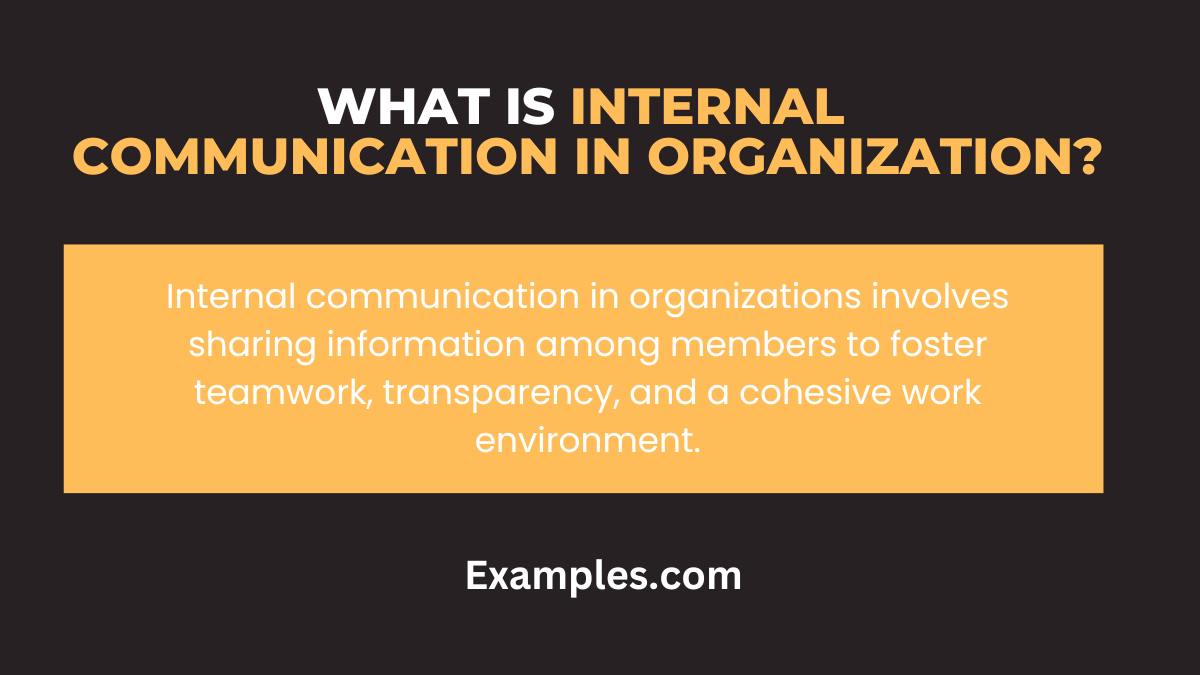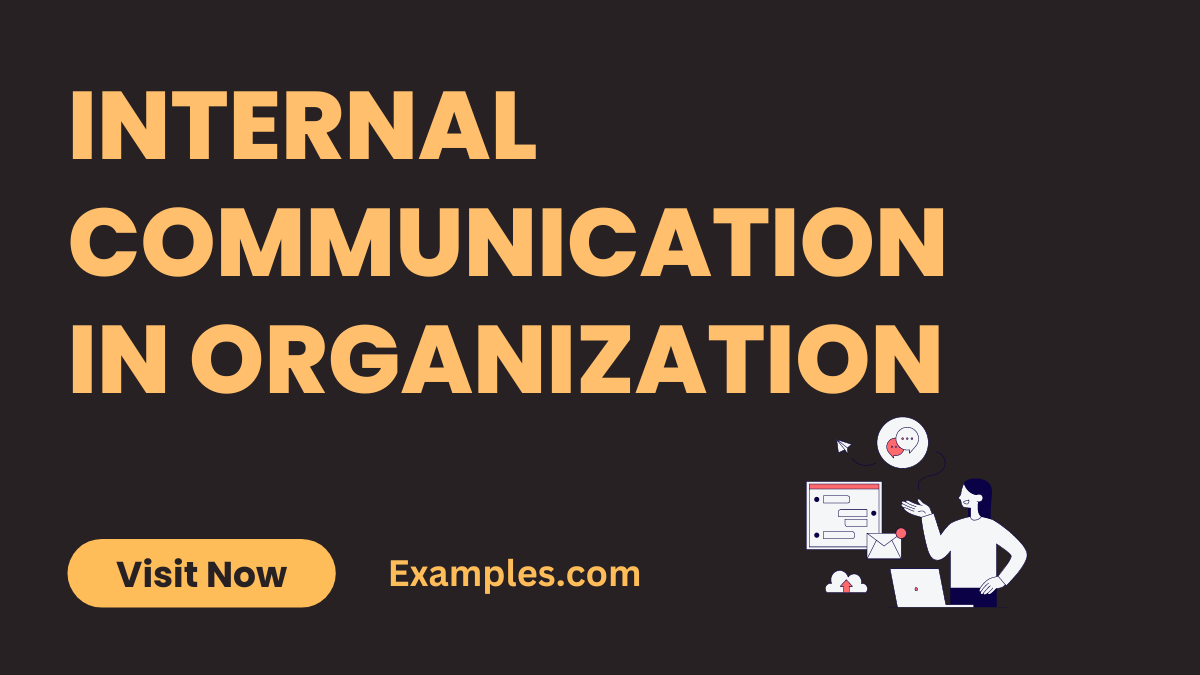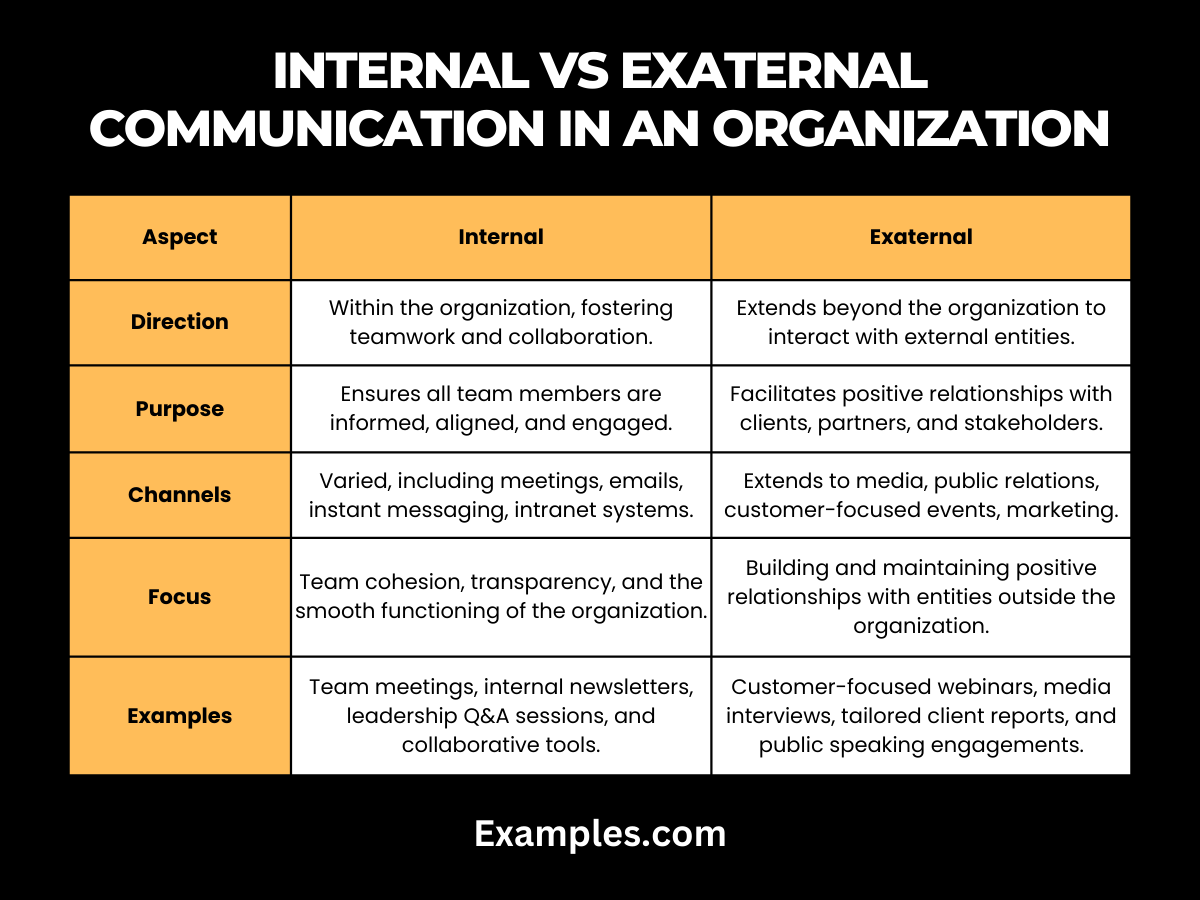19+ Internal Communication in Organization Examples
Enhance workplace dynamics with our comprehensive guide on Internal Communication in Organizations. Discover the significance of fostering robust connections within teams. This detailed exploration covers everything from the importance of effective communication examples to practical solutions. Unravel the complexities of organizational dynamics, and equip yourself with actionable insights to elevate communication within your team. Embrace a more connected and collaborative work environment today.
What is Internal Communication in Organization?

Internal communication within an organization is the intricate network of information exchange among its members. In simple terms, it involves the sharing of ideas, updates, and messages among all team members. This process aims to ensure everyone is aligned with the organizational goals and works collaboratively. Whether conveyed through meetings, emails, or instant messaging, internal communication fosters transparency and cohesion. It plays a pivotal role in creating a collaborative work environment and is essential for the smooth functioning of any organization. Effective internal communication is key to a well-connected and productive workplace.
What is the best Example of Internal Communication in Organization?
Internal communication is exemplified through various strategies, but one standout example is the implementation of a robust intranet system. A well-designed intranet serves as a centralized hub for sharing information, fostering collaboration, and promoting transparency among employees. Through the intranet, team members can access important updates, company news, and relevant documents. Features like discussion forums and messaging platforms enhance real-time communication, breaking down silos and ensuring everyone stays informed. This dynamic example showcases how a streamlined and accessible internal communication platform can significantly elevate organizational connectivity and efficiency.
20 Internal Communication in Organization Examples

Explore a comprehensive guide to 20 Internal Communication examples that redefine workplace connectivity. From enhancing team collaboration to streamlining information flow, these examples showcase best practices.
- Team Meetings: Foster open dialogue through regular team meetings, ensuring everyone is on the same page.
- Company Newsletters: Disseminate important updates and announcements via engaging newsletters, promoting transparency.
- Instant Messaging Platforms: Utilize platforms like Slack for quick, real-time communication, enhancing team responsiveness.
- Intranet Systems: Create a centralized hub for information sharing, facilitating seamless access to company resources.
- Interactive Workshops: Conduct workshops that encourage active participation, promoting a culture of open communication.
- Feedback Sessions: Implement regular feedback sessions to address concerns and gather valuable insights from team members.
- Employee Surveys: Use surveys to gauge employee satisfaction, enabling data-driven improvements in communication strategies.
- Leadership Town Halls: Organize town hall meetings to foster direct communication between leadership and employees.
- Collaboration Tools: Integrate tools like Google Workspace to enhance collaborative efforts and streamline communication.
- Social Intranet Platforms: Foster a sense of community through internal social platforms, encouraging informal interactions.
- Task Management Systems: Utilize tools like Asana to enhance task visibility, improving communication on project progress.
- Video Conferencing: Embrace virtual meetings for remote teams, facilitating face-to-face communication regardless of location.
- Employee Recognition Programs: Implement programs that celebrate achievements, boosting morale and communication.
- Knowledge Sharing Sessions: Encourage employees to share expertise through dedicated knowledge-sharing sessions.
- Cross-Functional Collaboration: Break down departmental silos by promoting collaboration across different teams.
- Internal Blogs: Create blogs to share insights, industry trends, and company updates, promoting a knowledge-sharing culture.
- Mobile Apps: Develop internal mobile apps for easy access to important information and updates on the go.
- Podcasts: Share insights and updates through internal podcasts, catering to diverse communication preferences.
- Recognition Wall: Establish a virtual wall where employees can publicly acknowledge and appreciate their peers.
- Project Collaboration Platforms: Utilize platforms like Basecamp for efficient project communication and collaboration.
Importance of Internal Communication in Organization:
Understanding the profound significance of internal communication in organizations is key to fostering a harmonious and productive work environment. Effective communication within a company is the linchpin of collaboration, transparency, and employee engagement.
Five Vital Examples of Internal Communication:
- Interactive Town Hall Meetings: In town hall meetings, leaders directly engage with employees, addressing concerns and fostering a sense of unity.
- Visual Communication Tools: Platforms like Miro or Canva facilitate visual collaboration, streamlining complex ideas into easily understandable visuals.
- Cross-Departmental Workshops: Conducting workshops that bring together employees from different departments encourages diverse perspectives and collaborative problem-solving.
- Internal Wiki Platforms: Establishing an internal wiki promotes a self-serve knowledge base, empowering employees to access information independently.
- Real-Time Chat Applications: Tools like Microsoft Teams enable instant communication, facilitating quick decision-making and enhancing team responsiveness.
Consequences of Ineffective Internal Communication in an Organization:
Ineffective internal communication can have profound repercussions on organizational dynamics, hindering collaboration and impeding progress. The consequences range from diminished employee morale to a decline in productivity and innovation. Misunderstandings, increased conflict, and a lack of clarity are all outcomes of communication breakdowns within an organization.
1. Low Employee Morale: Inadequate communication leaves employees feeling disconnected, impacting morale. Nurture a positive work environment through clear communication channels.
2. Diminished Productivity: Communication gaps lead to confusion and inefficiency. Streamline processes and improve productivity by fostering transparent and effective communication.
3. Increased Conflict: Ambiguity can breed conflict. Clearly communicate expectations and responsibilities to minimize misunderstandings and promote a harmonious workplace.
4. Lack of Innovation: Without effective communication, innovative ideas may go unheard. Establish platforms for idea-sharing to foster a culture of innovation and creativity.
5. Decreased Employee Engagement: Ineffective communication diminishes engagement. Enhance employee involvement by implementing communication strategies that prioritize clarity and transparency
How to Improve Internal Communication in an Organization?
Enhancing Internal Communication in Organizations
Boost organizational success with improved internal communication. Follow these key steps:
1. Transparent Channels: Encourage open dialogue to facilitate idea exchange.
2. Tech Tools: Leverage platforms like Slack for efficient communication.
3. Communication Plan: Develop a clear plan for purposeful and frequent communication.
4. Clarity Matters: Prioritize clear and concise messaging to avoid confusion.
5. Feedback Loop: Establish a feedback system for continuous improvement.
6. Training Programs: Conduct communication training for skill enhancement.
7. Multichannel Approach: Diversify communication channels for broader reach.
8. Recognition Culture: Celebrate achievements to foster a positive environment.
9. Streamlined Information: Ensure seamless information flow across departments.
10. Two-Way Communication: Promote dialogue over monologue for better engagement.
11. Clear Protocols: Define protocols for urgent communications.
12. Visual Elements: Use infographics for engaging information delivery.
13. Transparency Culture: Cultivate a transparent culture within the organization.
14. Assess Effectiveness: Regularly evaluate communication strategies for improvement.
15. Human Connection: Emphasize interpersonal connections for a stronger team.
In conclusion, mastering internal communication is pivotal for organizational success. This comprehensive guide has provided insights, strategies, and practical examples to elevate your approach. From fostering open dialogue to leveraging technology and recognizing achievements, these tactics ensure a communicative, collaborative, and thriving workplace. Implement these practices to cultivate a culture of effective internal communication and propel your organization towards sustained success.




